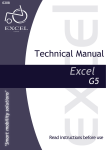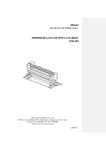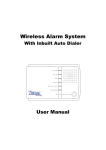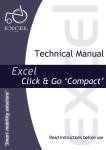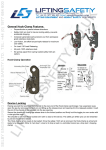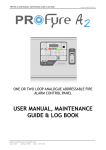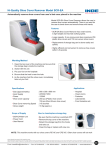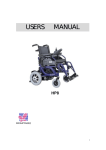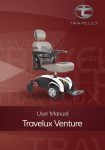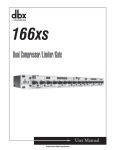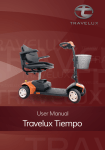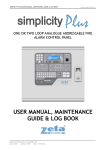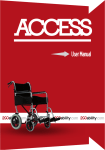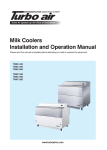Download Excel G6 user manual
Transcript
Excel G6 user manual © 2008 VAN OS MEDICAL UK LTD., Corunna House Business Centre, 42-44 Ousegate, Selby, North Yorkshire, YO8 4NH Tel. +44(0)1757 701177, Fax +44(0)1757 706011, E-mail: [email protected], www.vanosmedical.com ~1~ Excel G6 user manual YOU AND / OR YOUR ATTENDANT MUST READ AND FULLY UNDERSTAND THIS MANUAL BEFORE USE General information You have just bought a Van Os Medical UK Ltd wheelchair and we want to thank you for the confidence in our EXCEL ® products. The EXCEL ® wheelchair is a quality product. It is adjustable in many different ways and can also be easily upgraded. The policy of Van Os Medical UK Ltd is to continually improve the quality and reliability of our products. We reserve the right, therefore, without prior notification, to alter this guide. It is important that your guide for the use of the wheelchair is read carefully. The manual contains important information about the safe use and maintenance of your wheelchair. We recommend that you keep this guide, it's also your proof of warranty and you will also find it useful for referring to at a later date. The safety instructions in this guide are general guidelines that must be seen as broad guidelines. It is possible that you develop your own ways for many common transactions. However, we advise you to consult a professional for assistance in developing safe and effective techniques with regards to your daily activities and your physical capabilities. Your new wheelchair requires frequent maintenance. Much of the maintenance you can do yourself. We want you to take your wheelchair once a year to be inspected by a professional. You will find a maintenance schedule later in this manual. You'll also find that this manual includes a detailed description of all the available settings of your wheelchair. Many of these options require, as well as repairs to your wheelchair, the knowledge of a professional. We therefore advise you to consult a professional if you need a modification or repairs to be carried out. Caution! In this guide you will also find informative comments, recommendations and warnings. These are clearly identified by the symbols and the appearance of the text. Tip Informative information Recommendation Damage to equipment is possible if recommendations are not followed Warning To avoid personal injury, warnings must be followed. Fill out the information on your authorized dealer below: Company: ………………………………………………………………… Address: ………………………………………………………………… ………………………………………………………………… Telephone number: ………………………………………………………………… Fax number: ………………………………………………………………… Email adress: ………………………………………………………………… Website: ………………………………………………………………… © 2008 VAN OS MEDICAL UK LTD., Corunna House Business Centre, 42-44 Ousegate, Selby, North Yorkshire, YO8 4NH Tel. +44(0)1757 701177, Fax +44(0)1757 706011, E-mail: [email protected], www.vanosmedical.com ~2~ Excel G6 user manual Contents 1. IDENTIFICATION ........................................................................................................................................................ 4 2. GENERAL EXPLANATION CONCERNING YOUR WHEELCHAIR .............................................................................. 5 2.1 2.2 3. COMPONENTS OF THE WHEELCHAIR ............................................................................................................................... 5 GENERAL EXPLANATION OF THE FUNCTION AND POSSIBILITIES OF YOUR WHEELCHAIR .......................................................... 5 SAFETY REGULATIONS .............................................................................................................................................. 6 3.1 3.2 4. GENERAL SAFETY REGULATIONS ...................................................................................................................................... 6 WARNINGS FOR SAFE USE .............................................................................................................................................. 6 INSTRUCTIONS FOR USE............................................................................................................................................ 8 4.1 4.2 4.3 4.4 5. SAFETY TIPS ................................................................................................................................................................... 8 TAKING PAVEMENTS AND UNEQUAL SURFACES ................................................................................................................ 9 GOING UP AND DOWN RAMPS .................................................................................................................................... 10 GOING UP AND DOWN STAIRS ..................................................................................................................................... 12 INSTRUCTIONS FOR USE AND OPPORTUNITIES IN YOUR WHEELCHAIR ............................................................... 13 5.1 5.2 5.3 5.4 5.5 5.6 5.7 5.8 5.9 5.10 5.11 5.12 5.13 6. TOOLS AND TECHNICAL INFORMATION ......................................................................................................................... 13 OPENING AND CLOSING THE WHEELCHAIR .................................................................................................................... 14 USE OF THE FOOT PLATE AND FOOTREST......................................................................................................................... 14 USING THE ELEVATING LEG SUPPORT (OPTIONAL) .......................................................................................................... 16 USING THE CALF PLATE ................................................................................................................................................. 17 USING AN AMPUTEE SUPPORT ....................................................................................................................................... 18 USING THE WHEELCHAIR BRAKE..................................................................................................................................... 19 USING THE ARMREST .................................................................................................................................................... 20 POTENTIAL USES AND FUNCTIONS OF THE BACK OF THE WHEELCHAIR ............................................................................... 22 USING THE REAR WHEEL AND ANTI-TIP WHEELS ................................................................................................................ 23 TYRE TABLE .................................................................................................................................................................. 23 USING ACCESSORIES AND OTHER OPTIONS ON YOUR WHEELCHAIR ................................................................................. 24 USE OF THE HEADREST (OPTIONAL ITEM) ........................................................................................................................ 25 TRANSPORT AND TRANSIT IN CAR ......................................................................................................................... 27 6.1 6.2 7. DE-ASSEMBLY ............................................................................................................................................................. 27 ASSEMBLY................................................................................................................................................................... 27 MAINTAINENCE ...................................................................................................................................................... 27 7.1 7.2 7.3 7.4 7.5 7.6 7.7 TYRES ......................................................................................................................................................................... 28 BRAKES....................................................................................................................................................................... 28 CROSS BRACE ............................................................................................................................................................ 28 REAR WHEEL ............................................................................................................................................................... 28 FRONT CASTOR AND FRONT CASTOR FORK .................................................................................................................... 28 UPHOLSTERY ............................................................................................................................................................... 29 CLEANING.................................................................................................................................................................. 29 8. PROBLEM ANALYSIS AND SOLUTIONS................................................................................................................... 29 9. WARRANTY .............................................................................................................................................................. 31 9.1 9.2 10. 10.1 10.2 WARRANTY APPLICATION ............................................................................................................................................ 31 WARRANTY DEFINITION ................................................................................................................................................ 31 SERVICE AND MAINTENANCE............................................................................................................................ 33 GENERAL M AINTENANCE INSTRUCTIONS ....................................................................................................................... 33 SERVICE CHECKLIST ..................................................................................................................................................... 34 © 2008 VAN OS MEDICAL UK LTD., Corunna House Business Centre, 42-44 Ousegate, Selby, North Yorkshire, YO8 4NH Tel. +44(0)1757 701177, Fax +44(0)1757 706011, E-mail: [email protected], www.vanosmedical.com ~3~ Excel G6 user manual 1. IDENTIFICATION Your wheelchair is equipped with a unique identification number. You can find this number on the cross frame of your wheelchair. Below is an example of the frame label you can find the identification number. Furthermore you will find the explanation of the various data stored on the frame label listed. 3 2 1 5 6 4 7 1. Production Date The date on which your wheelchair was made. 2. Serial Number Every wheelchair has its own unique identification number YOU must have this when making technical requests or if warranty parts are required. 3. Maximum user weight Up to admissible usage for this wheelchair. 4. Type number This number indicates which model of wheelchair you have, again this is always required when making technical calls. 5. Model Name The model name of your wheelchair starts Excel with the mark name. The mark name Excel, followed by three figures and an additional model description forms the model name of your wheelchair. 6. Usage Application Where you can use your wheelchair. 7. Warranty guarantee conditions. Here the guarantee period on your wheelchair is reflected. Chapter 9 sees the © 2008 VAN OS MEDICAL UK LTD., Corunna House Business Centre, 42-44 Ousegate, Selby, North Yorkshire, YO8 4NH Tel. +44(0)1757 701177, Fax +44(0)1757 706011, E-mail: [email protected], www.vanosmedical.com ~4~ Excel G6 user manual 2. GENERAL EXPLANATION CONCERNING YOUR WHEELCHAIR 2.1 1 Components of the wheelchair 2 17 17 16 3 4 15 5 18 6 14 7 8 9 13 10 11 12 1 2 3 4 5 6 7 8 9 Back upholstery Push handle Backrest Hoop Rear wheel Brake Axel bracket Anti-tip Cross bar 10 11 12 13 14 15 16 17 18 Bearing house Front fork Front wheel (swing castor) Foot plate Foot rest Seat upholstery Armrest Backrest tensionbar Backrest incl. tension straps Your wheelchair is equipped with a number of elements and parts. You should know these before continue reading this manual. Your wheelchair can be equipped with options and accessories not pictured. You will see this yourself whilst reading this manual. Designs and specifications may change without prior notice. 2.2 General explanation of the function and possibilities of your wheelchair Your wheelchair is a foldable one, which is designed to be easy to transport in a car. Mainly, we divide the wheelchairs into two categories: self propel version with large rear wheels, and the transit version with small rear wheels. The type you own is stated on the frame label; after the numbers behind brand name EXCEL, there is a capital S (stating a self propel) or the capitals ST (stating a transit wheelchair). Your wheelchair is a product falling into the medical equipment and is not a standard consumer product. You must follow this manual completely to ensure good, optimal and safe use of your wheelchair. © 2008 VAN OS MEDICAL UK LTD., Corunna House Business Centre, 42-44 Ousegate, Selby, North Yorkshire, YO8 4NH Tel. +44(0)1757 701177, Fax +44(0)1757 706011, E-mail: [email protected], www.vanosmedical.com ~5~ Excel G6 user manual 3. SAFETY REGULATIONS VAN OS MEDICAL UK Ltd specifically disclaims responsibility for any body injury or property damage which may occur during any use which does not comply with laws or ordinances. If used correctly, the Excel wheelchair is an utmost safe and stable product, if the instructions for use as described in this manual are followed. However, it is possible when the Excel wheelchair is not used correctly, dangerous situations may occur. 3.1 General safety regulations Protect your Excel wheelchair by checking it regularly. When a part of your Excel wheelchair is not functioning properly, a dangerous situating could occur. YOU MUST KEEP YOUR WHEELCHAIR IN A GOOD CONDITION TO ENSURE SAFETY IN USE. Periodical inspection, correct adjustment of your wheelchair and timely replacement of damaged and worn parts will result in use for years without any problems. A qualified Van Os Medical UK Ltd dealer, who will use only Van Os Medical UK Ltd replacement parts, will take care of your wheelchair to ensure a long lifetime. Warning: YOU must your keep wheelchair in a good state to be able guarantee use and ambulatory the security in. 3.2 Warnings for safe use Warnings: - - do not use your wheelchair on streets or roads, only on the pavements; do not use your wheelchair in sand, rough area, wet and glade surfaces or surfaces with little grip; the transport of your wheelchair is in all vehicles, including vehicles which are adapted developed especially and/or for the transport of your wheelchair, at your own risk. We accept absolutely no liability for this. We recommend you, if you want nevertheless to transport your wheelchair, to contact a recognised manufacturer of taxi fixations to take with the carrier, your supplier and/or systems to choose an appropriate system for your wheelchair and situation; do not try to ascend ramps without installed anti tippers, never ascend a hill without anti tippers; do not lean concerning the back of the wheelchair. This can result in rolling over the wheelchair; before leaning or reaching forward, sit back into the chair and face the castors forward. 1 2 © 2008 VAN OS MEDICAL UK LTD., Corunna House Business Centre, 42-44 Ousegate, Selby, North Yorkshire, YO8 4NH Tel. +44(0)1757 701177, Fax +44(0)1757 706011, E-mail: [email protected], www.vanosmedical.com ~6~ Excel G6 user manual - A ‘wheelie’ is extremely dangerous to the user and will cause serious damage to the wheelchair 3 - Never connect anything to the wheels, this may cause damage to the chair and also effect the balance of the chair and may injure the user; Do not stand on the footrest this will cause the chair to tip and injure the user (figure 4); 4 - For suitable protection of potential obstruction the lowest point of the footrests serves minimum 7 cm free of the ground; Place the wheelchair on a stable, flat surface and attach the brakes before you get off or. Attach the brakes when you use the wheelchair in a lift or on wheelchair lift and when you get off; 5 - The standard weight capacity has been indicated on your frame label; Unauthorized modification and or use of no Van Os Medical parts will void the warranty of this chair and may lead to injury to the user and damage to the chair. © 2008 VAN OS MEDICAL UK LTD., Corunna House Business Centre, 42-44 Ousegate, Selby, North Yorkshire, YO8 4NH Tel. +44(0)1757 701177, Fax +44(0)1757 706011, E-mail: [email protected], www.vanosmedical.com ~7~ Excel G6 user manual 4. INSTRUCTIONS FOR USE You will have to learn the characteristics of your wheelchair. It is most important to learn the safest methods to develop the daily activities in accordance to your life style. Consult your medical advisor or therapist for assistance by developing safe and effective techniques for your daily activities and your physical possibilities. 4.1 Safety Tips Daily operations of and getting off the wheelchair, reaching and bending in wheelchair weight distribution will change the centre of gravity of you in your wheelchair, you will need to become comfortable with these movements to perform any techniques shown below. Transferring Transferring in a wheelchair is a difficult manoeuvre. Consult your physical therapist for assistance in developing your individual technique. Making a transfer and the possibilities you have are depending on your physical characteristics. We advise to discuss this first with your physical therapist If you have however sufficient body strength and you want transfer to and from the wheelchair can you this best in the following manner: To get off from the wheelchair: First of all you must ensure that your wheelchair stand as closely as possible to the place of where you want sit will. Put castors forward and attach the brakes. Swing away the footplates and place your feet on the ground. YOU are now in position carry out the operation. Shift your weight forward in the direction to the front of your chair use the armrests as a support and move to yourself to the place where you want sit. If necessary you can use of transfer board. To get in: In your wheelchair to step you must the same do things such as at from your chair step, only in reversed order. Reaching / bending forwards 1 Take great care that you are as close as possible as the target object; 2 Drive forward until you are above the object you want to reach and than back and sideward so that the front wheels are turning to the front. 3 Engage the wheel brakes; 4 Keep the object you want to grab as close as possible to the wheelchair. 6 © 2008 VAN OS MEDICAL UK LTD., Corunna House Business Centre, 42-44 Ousegate, Selby, North Yorkshire, YO8 4NH Tel. +44(0)1757 701177, Fax +44(0)1757 706011, E-mail: [email protected], www.vanosmedical.com ~8~ Excel G6 user manual Reaching / bending sideward 1 2 3 Manoeuvre the chair as close as possible to the object you want to reach; Ensure that the front wheels are fully turned to the front. If not, go forwards and then backwards to turn the wheels fully to the front; Keep the object you want to grab as close as possible to the wheelchair (picture 7 and picture 8) 7 8 Reaching / bending backward 1 2 3 Manoeuvre the chair as close as possible to the object; the rear wheels will indicate how close you can; Do not reach further than your arm can reach. If you are in doubt, you reposition the chair (picture 9); Do not engage the wheel locks. If your weight moves while reaching, it is better to drive in that direction than tipping the wheelchair. 9 4.2 Taking pavements and unequal surfaces Going up the pavement: If you ascend a pavement, we advise to do this together with an attendant. The attendant must pull the push handles towards him and place his foot on the stepper on the rear side of the wheelchair. Because of this there is a lever effect that tips the wheelchair (see picture 10). 10 © 2008 VAN OS MEDICAL UK LTD., Corunna House Business Centre, 42-44 Ousegate, Selby, North Yorkshire, YO8 4NH Tel. +44(0)1757 701177, Fax +44(0)1757 706011, E-mail: [email protected], www.vanosmedical.com ~9~ Excel G6 user manual If you alone on the pavement wish to go up, you should move your weight as far forward as possible by bending forward. Then you must provide a so-called 'Wheelie', to get the front wheels on to the curb, to allow you to climb the curb (see Figure 3, under the heading "Warnings for safe use). You can only perform this action if you have practiced it with a trained expert. Going down the pavement: If you want to go down the pavement, we advise you to do this with an attendant. The attendant should move the wheelchair forward to the curb. Then the user should lean back so the instructor can tilt the wheelchair to find a balance point. When the wheelchair is balanced the attendant can move the wheelchair slowly off the curb. When the wheelchair is off the pavement, the attendant can let the front wheels back onto the ground. If you want to independently go off the pavement, you should do this in reverse (Figure 11 shows what not to do). You can do this only if you've practiced with an expert. 11 4.3 Going up and down ramps Most people can climb short slopes by themselves. This of course depends on your body strength, stamina and the gradation of the slope. Inspect the slope always for risks, such as holes or slippery and uneven surfaces before you drive off. If you can not see the slope, ask someone to inspect it for you. Warning: A slope of more than 5 degrees can be dangerous to descending or climb. Remember that the friction of your hands to grab the push handles is the only way to brake while driving. Most people develop their own methods to drive up slopes through practice. Sit with your upper body slightly forward as you climb the slope. Should it be necessary to stop on the slope, then avoid unexpected movements that tilting forward as you may cause further climbs (Figure 12). 12 If you want to climb a relatively steep slope, we advise you to use the assistance of a supervisor. 13 © 2008 VAN OS MEDICAL UK LTD., Corunna House Business Centre, 42-44 Ousegate, Selby, North Yorkshire, YO8 4NH Tel. +44(0)1757 701177, Fax +44(0)1757 706011, E-mail: [email protected], www.vanosmedical.com ~ 10 ~ Excel G6 user manual We recommend you to use anti-tip wheels. Depending on the model of your Excel wheelchair sometimes these are a standard item and sometimes they are an optional extra. They prevent you from tipping the wheelchair over backwards (Figure 12). Do not carry any weight on the back of the wheelchair whilst ascending (Figure 13). This changes the balance and increases the chances of tipping backwards. 14 Make sure you descend a slope at the lowest part, also make sure the bottom of the footrest doesn’t catch on the ground. This is in order to ensure your safety at the end of the slope. Do not lean forward as this can cause overturning. Lean slightly backward in order to increase stability. Make sure the wheelchair is always kept under control. Do not hurry down the slope, but move slowly and safely. The speed of descent is controlled by the amount of grip strength to the push handles is exercised. In an effort to prevent friction burns to your hands, it is recommended that you use gloves. To reduce the risk that you burn your hands or lose control over the wheelchair, you might want to slow down. Do not use the wheel brakes during the descent. The wheel brakes are designed for static braking of the rear wheels whilst stationary. Avoid changing direction as you descend. Despite that your EXCEL ® wheelchair is designed for balance and control, a change of direction on the slope and change the balance will cause instability. If you are using an attendant they should be aware that even with a slight slope already considerable traction should be exercised (Figure 15). 15 Warning: Using the wheel brakes to slow down the wheelchair whilst driving will cause a sudden stoppage. The result may be that the chair rotates to one side and tilts, or abrupt stops so that the seat tilts forward. If your wheelchair is used in an environment where there are many slopes, it is advisable to fit a drum braking system for the attendant to use. © 2008 VAN OS MEDICAL UK LTD., Corunna House Business Centre, 42-44 Ousegate, Selby, North Yorkshire, YO8 4NH Tel. +44(0)1757 701177, Fax +44(0)1757 706011, E-mail: [email protected], www.vanosmedical.com ~ 11 ~ Excel G6 user manual 4.4 Going up and down stairs Stairs are one of the largest obstacles for wheelchair users. However, with a little help from others it is possible to climb up and downstairs when a wheelchair lift is not available. You must be aware of the rather heavy weight to be placed. We advise climbing stairs with a wheelchair with the help of a minimum of two attendants. You must always face the rear wheels towards the stairs. The wheelchair must be tipped, so the gravitation force is as low as possible and the wheelchair is in balance. If you lift the wheelchair, you should do this by holding the side frame parts (picture 17). 16 17 7 Going down stairs This action again should be carried out with two attendants. Take one step at a time and go slowly. The attendants must make sure the wheelchair is tipped and also must secure the wheelchair to counter-act the force of gravity. Warning: Never lift a wheelchair by the push handles, armrests or footrests (picture 16). Always hold a part of the main frame. © 2008 VAN OS MEDICAL UK LTD., Corunna House Business Centre, 42-44 Ousegate, Selby, North Yorkshire, YO8 4NH Tel. +44(0)1757 701177, Fax +44(0)1757 706011, E-mail: [email protected], www.vanosmedical.com ~ 12 ~ Excel G6 user manual MAKING ADJUSTMENTS TO YOUR WHEELCHAIR CAN CAUSE BIG RISKS FOR YOUR SAFETY AND THE FUNCTION OF YOUR WHEELCHAIR ADJUSTMENTS MADE BY YOURSELF ARE STRONG ADVISED AGAINST AND CARRIED OUT AT YOUR OWN RISK ALWAYS SEEK ADVICE FROM AN APPROVED DEALER BEFORE MAKING ADJUSTMENTS 5. INSTRUCTIONS FOR USE AND OPPORTUNITIES IN YOUR WHEELCHAIR In this chapter we will explore all the possibilities that you have with your wheelchair. All options will be discussed, but all use instructions such as the removal of the footrest. Your wheelchair is an Excel G6 ®. All these detailed models are available in self propel and transit wheel versions, see Section 2.2 for further explanation on this. You can find details about your wheelchair on the label on the cross brace where you can see the exact specifications. Further on in this chapter are details about specific options referring to the different versions. Warning: We advise you, if you want to make changes where tools are needed, to consult with your dealer. 5.1 Tools and technical information For the maintenance of your wheelchair, in some cases, you need tools. For your wheelchair the following tools are required: Phillips screwdriver Allen keys Cross-ring or keys Spanners Socket wrench PH2 4, 5 and 6 mm 8, 10, 13 and 26 mm 19 and 22 mm 19 mm Excel ® G6 Seat widths Seat depths Seat heights Backrest height Total width Total length Total height Folded width Weight (complete) Transport Weight Maximum User Weight 40, 42 ½, 45 and 50 cm 40, 43, 46 and 49 cm 43, 45, 47½, 50, 51½ and 53 cm 42½, 45 and 47½ cm (adjustable) 17 cm + seat width > 100 cm > 95 cm 31 cm 14.9 kg 9.2 kg 130 kg (150 kg combined with seat with 50 cm) © 2008 VAN OS MEDICAL UK LTD., Corunna House Business Centre, 42-44 Ousegate, Selby, North Yorkshire, YO8 4NH Tel. +44(0)1757 701177, Fax +44(0)1757 706011, E-mail: [email protected], www.vanosmedical.com ~ 13 ~ Excel G6 user manual 5.2 Opening and closing the wheelchair Opening the wheelchair From the folded position stand to the side of the wheelchair. - Hold the armrest of the side closest to you, and tilt the wheelchair slightly towards you. - Push the seat side tubes downwards, this will unfold the wheelchair. - Then, to full open the wheelchair, push the side tubes of the seat frame into place, see Figure 1. - Make sure the side tubes are now in the seat receiving brackets on the main frame. - If you have removed them, place any foot or leg option back onto the wheelchair. You can now use the wheelchair. Fold the foot plates up and possibly remove the footrest where possible. Make sure you are next to the wheelchair. Get a hold of the handles (black material hand loops not the armrests) at both sides of the seat and pull upwards simultaneously. Tilt the wheelchair slightly and push the two sides together to complete the folding. Folding the wheelchair - Fold away the foot plates and possibly remove the foot or leg option. Make sure you are next to the wheelchair. Get a hold of the seat material at the front and rear in the middle and pull straight up towards, see Figure 2. Tilt the wheelchair slightly and then push the sides toward each other to completely the wheelchair. Figure 1 5.3 Figure 2 Use of the foot plate and footrest Folding the footplate away - For using your wheelchair, you are required to put the footplate down, see figure 3 - To fold the footrest away you need to move it in the direction of the main part of the footrest, see figure 4. Make sure the heel strap does not get stuck between the footplate and footrest, see Figures 3 and 4 Figure 3 Figure 4 Swinging the footrests towards and away from your wheelchair - Fold the footplate away (see previous section) - Pull the black control lever to release the footrest, see Figure 5 - You can now move the complete footrest inwards or outwards without removing it © 2008 VAN OS MEDICAL UK LTD., Corunna House Business Centre, 42-44 Ousegate, Selby, North Yorkshire, YO8 4NH Tel. +44(0)1757 701177, Fax +44(0)1757 706011, E-mail: [email protected], www.vanosmedical.com ~ 14 ~ Excel G6 user manual Removing the footrests from your wheelchair - Fold the footplate away (see earlier in this chapter) - Pull the black control lever, as shown in Figure 5. You can now swing the footrest inwards and outwards - Swing the footrests 90 ˚ to the outside of your wheelchair and pull the complete footrest straight up from the mounting tube Replacing the footrest back on your wheelchair - Attach your folded footrest back to the frame at an angle of 90° swung outwards - Turn the footrest so that it is parallel with your frame, as shown in Figure 5 - You should hear a click. This click confirmed that the foot is in position Setting height of the foot plate - Turn the black button on the footrest independently, see Figure 6 - Select the desired height, make sure the holes in the top two tubes together and turn the black button until tight - Make sure the foot plate is in place and that the length is equal on both sides Figure 6 Figure 5 Setting height of the foot plate (socket) For adjusting the height of the footplate you need to use the enclosed wrench number 6 - Tighten the bolt on the footrest independently, see Figure 6 - Select the desired height and tighten the bolt down - Make sure the foot plate is in place and that the length is equal on both sides Setting angle of the foot plate There are two different types of foot where it is possible to adjust the angle of the foot plate. You can decipher which footrest you have by looking at it. One type has stepped adjustment (figure 7) and the other has infinite adjustment (figure 8) Figure 8 Figure 7 Footrest 1 (stepped adjustment, figure 7) To adjust the angle of this footplate, you have to use the supplied wrench number 5 - The footplate can now be removed for the footrest. Select the desired angle of the plate and turn the screw well. Note the help dashes at the foot plate for choosing the desired angle Make sure the footplate is in place Footrest 2 (infinite adjustment, figure 8) To adjust the angle of this footplate you sit in the wheelchair and use your feet on the footplates to find the correct angle. On this footrest the footplate you can never be fully secure but is still safe for use. You can fasten the footplate securely with the supplied wrench (No. 5) on the side of the foot plate. © 2008 VAN OS MEDICAL UK LTD., Corunna House Business Centre, 42-44 Ousegate, Selby, North Yorkshire, YO8 4NH Tel. +44(0)1757 701177, Fax +44(0)1757 706011, E-mail: [email protected], www.vanosmedical.com ~ 15 ~ 0 Excel G6 user manual Setting the footplate depth To adjust the depth of your footplate you need the enclosed wrench number 5 - You run with the help of the wrench loosen the footplate, figure 9 - You can now move the footplate forwards and backwards. Set the desired depth and tighten the foot plate - Make sure the footplate is in place and the depth in both plates is equal Figure 9 5.4 Using the elevating leg support (Optional) Swinging the elevating legrest(s) away - Pull the black button upwards, see Figure 10 - You can now swing your elevating legrest(s) inwards and outwards Removing the elevating legrest(s) from your wheelchair - Pull the black button upwards, see Figure 10. - You can now swing your elevating legrest(s) inwards and outwards - Swing the elevating leg support 90 ˚ to the outside of the wheelchair and pull it straight up from the receiving tube Replacing the elevating legrest(s) back on your wheelchair - Attach your elevating legrest back to the frame at an angle of 90° swung outwards, figure 11 - Turn the legrest so that it is parallel with your frame, as shown in Figure 10 - You should hear a click. This click confirmed that the foot is in position Setting height of the elevating legrest(s) - Turn the black button on the elevating legrest, see Figure 12 - Select the desired height, make sure the holes in the top two tubes are together and turn the black button down - Make sure the comfort leg support in the desired position Figure 10 Figure 11 Figure 1212 Figure © 2008 VAN OS MEDICAL UK LTD., Corunna House Business Centre, 42-44 Ousegate, Selby, North Yorkshire, YO8 4NH Tel. +44(0)1757 701177, Fax +44(0)1757 706011, E-mail: [email protected], www.vanosmedical.com ~ 16 ~ Excel G6 user manual Setting angle of the elevating legrest - Move the joystick with the black button toward the wheelchair. The gas spring in the comfort leg support moves up automatically, see Figure 13 - If you support the comfort leg downwards want to move, you control lever with the black button toward the wheelchair to maintain and support the leg while gently pushing down Figure 13 5.5 Using the calf plate Folding the calf plate back - Get a hold of the calf plate and put it into the position shown on the first picture of figure 14. rotate around the legrest as shown on the last two pictures of figure 14. Figure 14 Setting angle of the calf plate - Hold the calf plate on the inside and by moving up and down, find the correct angle, see figure 15 - If the calf plate is too stiff to move then you can use the supplied wrench (No. 6) to loosen. Once you have the desired angle you can then tighten, figure 16 Figure 16 Figure 15 © 2008 VAN OS MEDICAL UK LTD., Corunna House Business Centre, 42-44 Ousegate, Selby, North Yorkshire, YO8 4NH Tel. +44(0)1757 701177, Fax +44(0)1757 706011, E-mail: [email protected], www.vanosmedical.com ~ 17 ~ Excel G6 user manual Setting the height of the calf plate In order to set the height of the calf plate, you have to use the number 4 supplied wrench - Remove the two screws, loose with the wrench, see figure 17 - Move the calf plate to the desired height and turn the retighten the screws - Make sure the calf plate in place Figure 17 5.6 Using an amputee support Swinging the amputee support away - Pull the black control lever, see figure 18 - You can now swing the amputee support inwards and outwards Removing the amputee support from your wheelchair - Pull the black control lever, see figure 18. You can now swing the amputee support inwards and outwards - Swing the amputee support 90 ˚ away from the wheelchair and pull it straight up from the receiving tube Replacing the amputee support back on your wheelchair - Attach your amputee support back to the frame at an angle of 90° swung outwards, figure 19 - Turn the legrest so that it is parallel with your frame, as shown in Figure 18 - You should hear a click. This click confirmed that the foot is in position Figure 18 Figure 19 Setting the angle of the amputee support - Hold the amputee aid at the top and bottom and by moving up and down, find the correct angle, see figure 20 - If the amputee aid is too stiff to move then you can use the supplied wrench (No. 6) to loosen. Once you have the desired angle you can then tighten, figure 21 Figure 20 Figure 21 © 2008 VAN OS MEDICAL UK LTD., Corunna House Business Centre, 42-44 Ousegate, Selby, North Yorkshire, YO8 4NH Tel. +44(0)1757 701177, Fax +44(0)1757 706011, E-mail: [email protected], www.vanosmedical.com ~ 18 ~ Excel G6 user manual Setting the height of the amputee support In order to set the height of the amputee support, you have to use the number 4 supplied wrench - Remove the screws, loose with the wrench, see figure 22 - Move the amputee support to the desired height and position and retighten the screws - Make sure the amputee support in place Figure 22 Figure 23 Setting the length of the amputation support In order to set the length of the amputation support, you require the supplied wrench number 5 - Remove the four screws with the wrench, see figure 22. You can now move the black tube around the silver tube - Move the amputee support to the desired position - Make sure all screws tightened. 5.7 Using the wheelchair brake Putting the wheelchair brake on If you are in the wheelchair - Lift the black lever part of the brake handle out, see figure 24 - Push the lever forward until you hear the click, this confirms that the wheelchair has put on the parking brake. If you are next to the wheelchair - Go to the side of the wheelchair and face towards the front of the wheelchair. Lift the black lever out - Push the lever forward until you hear the click, this confirms that the wheelchair has been put on the parking brake Figure 24 © 2008 VAN OS MEDICAL UK LTD., Corunna House Business Centre, 42-44 Ousegate, Selby, North Yorkshire, YO8 4NH Tel. +44(0)1757 701177, Fax +44(0)1757 706011, E-mail: [email protected], www.vanosmedical.com ~ 19 ~ Excel G6 user manual Putting the wheelchair on the parking brake and the folding the brake away If you are in the wheelchair - Take the black handle of the brake down, see figure 24.1. - Push the lever forward until you hear the click, this confirms that the wheelchair has put on the parking brake - You can now hide the black lever away, draw upwards and push backwards Figure 24.1 If you are next to the wheelchair - Go to the side of the wheelchair and face towards the front of the wheelchair. Lift the black lever out - Push the lever forward until you hear the click, this confirms that the wheelchair has been put on the parking brake - You can now hide the black lever away, draw upwards and push backwards Using drum brakes Sometimes a wheelchair will be fitted with drum brakes which can be found on the push handles of the wheelchair - Squeeze the lever toward the black push handle to brake, see figure 25. Figure 26 Figure 25 You can also put a parking brake on - Squeeze the lever toward the black push handle - Keep the lever there and push the button on the black lever forward to brake, see figure 26; - Reverse this to remove the parking brake 5.8 Using the armrest Flipping the armrest backwards If you are in the wheelchair - Where the front of the armrest meets the frame you will find a black lever. Pull the black lever to the frame, see figure 27 - You can now swing the armrest backwards because it will be attached to the frame at only one point at the rear of the armrest - To put the armrest back in place you must reverse the previous steps. Please make sure you hear the click that confirmed that the armrest back in place Removing the armrest completely - Where the front of the armrest meets the frame you will find a black lever. Pull the black lever to the frame, see figure 27 © 2008 VAN OS MEDICAL UK LTD., Corunna House Business Centre, 42-44 Ousegate, Selby, North Yorkshire, YO8 4NH Tel. +44(0)1757 701177, Fax +44(0)1757 706011, E-mail: [email protected], www.vanosmedical.com ~ 20 ~ Excel G6 user manual - You can now swing the armrest backwards because it will be attached to the frame at only one point at the rear of the armrest To release the armrest from the frame pull the black knob backwards, see figure 28 To put the armrest back in place you must reverse the previous steps. Please make sure you hear the click that confirmed that the armrest back in place Figure 27 Figure 28 Adjusting the armrest height with a button (optional armrest) - Press the button with one hand and move with your other hand the arm pad up or down, see figure 29 - If the arm pad is at the desired height you should release the button. You will hear a click, the arm pad will now remain at the desired height until you press the button again Figure 29 Removing the armrest (optional armrest) - Push the release button in - Pull the arm pad perpendicularly upwards from the wheelchair Adjusting the armrest height (optional armrest) To adjust the height of this armrest, you have to use the supplied wrench number 4 - Loosen the screw with the supplied wrench, see figure 30 - Move the armrest to the correct height and tighten the screw back down - Make sure the screw and armrest are both in place Figure 31/32 Figure 30 Push handles height-adjustable - Turn the black lever, until you can move push handles. See figure 31 - Move the push handles to the desired height and tighten the black lever back on - You should make sure the lever is in a place where it is not an obstacle - Make sure the handle is in the correct place Push handles height and angle adjustable - Turn the black lever, until you can move push handles. See figure 32 © 2008 VAN OS MEDICAL UK LTD., Corunna House Business Centre, 42-44 Ousegate, Selby, North Yorkshire, YO8 4NH Tel. +44(0)1757 701177, Fax +44(0)1757 706011, E-mail: [email protected], www.vanosmedical.com ~ 21 ~ Excel G6 user manual - Move the push handles to the desired height; Or move the push handle 90˚ inwards so that the overall length on the wheelchair falls. This saves a lot of space when you take the wheelchair in the car Turn back on the black lever You should make sure the lever is in a place where it is not an obstacle Make sure the handle is put down 5.9 Potential uses and functions of the back of the wheelchair Using the tension bar - If your wheelchair folds out the tension bar is the last item to lock into place and may require pulling upwards to do so. You can move the tension bar by using the nylon loop see figure 33 - If you wish to fold your wheelchair you must first release the tension bar. You can do this by pulling the nylon loop of the tension bar downwards gently Figure 33 Using the back tension straps With eight back straps on the wheelchair, you can fully customize the back of the wheelchair to suit your own body - Get behind the wheelchair and first remove backrest upholstery that is an independent item that is attached to the tension straps with Velcro - When you have removed the backrest upholstery you will see eight straps. These can be adjusted to the desired tension, simply release the Velcro, put the strap in the desired position and reattach the Velcro - When you're finished, place the backrest upholstery back and you can use the wheelchair Backrest angle setting On your wheelchair you have the opportunity to adjust the angle of the back. We advise that this procedure is conducted by an authorized @ Excel dealer. Adjusting the height of the backrest (European backrest models only) - Make sure the armrests are folded away - Turn on both sides a black button or nut that you find on the backrest tube, completely independently, and see figure 34 - Remove the drumstick on both sides that is still in the backrest tube located - You can now move the backrest up and down - When the seat back is at the desired height, you push the bolts back into the backrest tubes and turn them back on with the black buttons or the two nuts. - Verify that the backrest is in place Figure 34 © 2008 VAN OS MEDICAL UK LTD., Corunna House Business Centre, 42-44 Ousegate, Selby, North Yorkshire, YO8 4NH Tel. +44(0)1757 701177, Fax +44(0)1757 706011, E-mail: [email protected], www.vanosmedical.com ~ 22 ~ Excel G6 user manual 5.10 Using the rear wheel and anti-tip wheels Removal of the rear wheel You can remove your rear wheels using the quick release system in the following way: - Tilt your wheelchair slightly so the wheel you wish to remove is slightly off the ground, see figure.... - Press the black button in the centre on the wheel and remove the axle and wheel from the frame. Make sure the black button is completely pressed in otherwise the ball bearing safety system that stops the wheel from being removed at the opposite side of the axle will do exactly that. - To put the rear wheel back in place you must reverse the above steps. In order to ensure your safety please make sure the axle is fully in place and the ball bearing system is engaged so the wheel does not come loose during use. 5.11 Tyre table Basic Compact Wheelchair model Rear wheel Tyre size front Maximum pressure front tyres Tyre size rear Maximum pressure rear tyres EXCEL® ‘Basic Compact’ Self propel 4,0 bar / 50 psi Transit 2,5 2,5 2,5 2,5 2,5 2,5 24" x 1 3/8" EXCEL® ‘Basic Compact’ 6" X 1 1/4" 8" X 1 1/4" 200 X 50 6" X 1 1/4" 8" X 1 1/4" 200 X 50 12" x 2 1/4" 2,8 bar / 40 psi bar bar bar bar bar bar / 36 / 36 / 36 / 36 / 36 / 36 psi psi psi psi psi psi G2, G3, G4 and G5 Type Designation Type wheelchair Tyre size front Maximum pressure front tyres Tyre size rear Maximum pressure rear tyres EXCEL® ‘G2’ Self propel 4,5 bar / 65 psi Transit 2,5 2,5 2,5 2,5 2,5 2,5 24" x 1 3/8" EXCEL® ‘G2’ 6" X 1 1/4" 8" X 1 1/4" 200 X 50 6" X 1 1/4" 8" X 1 1/4" 200 X 50 12" x 2 1/4" 2,8 bar / 40 psi bar bar bar bar bar bar / 36 / 36 / 36 / 36 / 36 / 36 psi psi psi psi psi psi G6 and Xeryus P and C Type Designation Type wheelchair Tyre size front Maximum pressure front tyres Tyre size rear Maximum pressure rear tyres EXCEL® ‘G6’ Self propel 7,5 bar / 110 psi 4,5 bar / 65 psi Transit 2,5 2,5 2,5 2,5 2,5 2,5 24" x 1" 22" x 1 3/8" EXCEL® ‘G6’ 6" X 1 1/4" 8" X 1 1/4" 200 X 50 6" X 1 1/4" 8" X 1 1/4" 200 X 50 12" x 2 1/4" 2,8 bar / 40 psi bar bar bar bar bar bar / 36 / 36 / 36 / 36 / 36 / 36 psi psi psi psi psi psi G7 Type Designation Type wheelchair Tyre size front Maximum pressure front tyres Tyre size rear Maximum pressure rear tyres EXCEL® 200 S 'G5' Lightweight / Active Self propel 4,2 bar / 60 psi 4,5 bar / 65 psi Transit 2,5 2,5 2,5 2,5 2,5 2,5 24" x 1 3/8" 22" x 1 3/8" EXCEL® 200 ST 'G5' Lightweight 6" X 1 1/4" 8" X 1 1/4" 200 X 50 6" X 1 1/4" 8" X 1 1/4" 200 X 50 12" x 2 1/4" 2,8 bar / 40 psi bar / 36 bar / 36 bar / 36 bar / 36 bar / 36 bar / 36 psi psi psi psi psi psi Using the anti-tip wheels © 2008 VAN OS MEDICAL UK LTD., Corunna House Business Centre, 42-44 Ousegate, Selby, North Yorkshire, YO8 4NH Tel. +44(0)1757 701177, Fax +44(0)1757 706011, E-mail: [email protected], www.vanosmedical.com ~ 23 ~ Excel G6 user manual - Go stand to the back of the wheelchair; When you get down to your knees you will see the operating system of the anti-tip wheels, see figure 35; Retracting the silver round (figure 36) Will cause the anti-tip wheel to slide; Let go of the silver round when the anti-tip wheel touches the ground; Make sure the anti-tip wheel is fastened correctly and does not move anymore. When you do not want to use the anti-tip, retract the silver round with one hand, while pushing up the anti-tip wheel, by sliding it up the holder. Figure 35 Figure 36 5.12 Using accessories and other options on your wheelchair The seat cushion Your wheelchair is equipped with a 5 cm thick, nylon seat cushion. This seat cushion is equipped with an anti-skid layer, see figure 39. You need the seat cushion with the anti-slip side down on your wheelchair to make sure it doesn’t move. Figure 39 Seat Belt (optional item) Your wheelchair is equipped with a seat belt which you can use the following way: - When in the wheelchair, you can fasten the belt by clicking the two loose ends together, see figure 40. - If the belt too loose or too tight about you can make it more secure or looser, see figure 41. - To release the seat belt, you press the red button with 'press' printed on. Figure 40 Figure 41 © 2008 VAN OS MEDICAL UK LTD., Corunna House Business Centre, 42-44 Ousegate, Selby, North Yorkshire, YO8 4NH Tel. +44(0)1757 701177, Fax +44(0)1757 706011, E-mail: [email protected], www.vanosmedical.com ~ 24 ~ Excel G6 user manual Taxi Fixation Points On your wheelchair, you will find taxi fixation indication points, see figure 42. You should be familiar with these items before transporting your wheelchair in a car or on a mini bus. We advise you to make contact with the carrier, your supplier and/or an approved manufacturer of taxi fixation systems for advice on an adequate system if you want to transport your wheelchair Figure 42 5.13 Use of the headrest (optional item) Removing the headrest - You can remove the headrest by using the black buttons (figure 43). On both sides fully loosen to run off the push handles. When these buttons are completely separate, you can remove the bolt and the headrest of the wheelchair will lift off - To replace the headrest back onto the wheelchair you should repeat the above in reverse order. - Make sure the headrest is secure before use Figure 44 Figure 43 Adjusting the height of the headrest - At the back of the in the middle of the tube of the headrest there is a black button - Turn this button, see figure 44. - You can now move the headrest up and down - When the headrest is at the desired height you should fix it there - Make sure the head in place before use Figure 45 Adjusting the headrest On the headrest there are three levers (figure 45) that allow you to adjust the headrest into the desired position. These levers work in the following way: © 2008 VAN OS MEDICAL UK LTD., Corunna House Business Centre, 42-44 Ousegate, Selby, North Yorkshire, YO8 4NH Tel. +44(0)1757 701177, Fax +44(0)1757 706011, E-mail: [email protected], www.vanosmedical.com ~ 25 ~ Excel G6 user manual - Turn the levers separately, never simultaneously Move the headrest to the desired position Turn the lever back until they are tight and possibly do the same with the other levers (if an adjustment is required) Make sure the head is secure in place and that the three levers are not obstacles MAKING ADJUSTMENTS TO YOUR WHEELCHAIR CAN CAUSE BIG RISKS FOR YOUR SAFETY AND THE FUNCTION OF YOUR WHEELCHAIR ADJUSTMENTS MADE BY YOURSELF ARE STRONG ADVISED AGAINST AND CARRIED OUT AT YOUR OWN RISK ALWAYS SEEK ADVICE FROM AN APPROVED DEALER BEFORE MAKING ADJUSTMENTS © 2008 VAN OS MEDICAL UK LTD., Corunna House Business Centre, 42-44 Ousegate, Selby, North Yorkshire, YO8 4NH Tel. +44(0)1757 701177, Fax +44(0)1757 706011, E-mail: [email protected], www.vanosmedical.com ~ 26 ~ Excel G6 user manual 6. TRANSPORT AND TRANSIT IN CAR Your Excel wheelchair is designed to be easily transported by car. Your wheelchair is foldable so the total width is limited to an average measure of 20 cm. Further your wheelchair is equipped with swing away detachable footrests. At the same time some wheelchairs can be equipped with a couple of size decreasing accessories, like quick release (detachable) rear wheels and a foldable backrest. 6.1 De-assembly Take away the foot rests on the front side of your wheelchair (see chapter ‘adjustments and mounting’ for a description). Remove the seat cushion if your wheelchair is equipped with one. Fold the wheelchair: stand next to the wheelchair and pull the seat upholstery straight up in the middle of the rear and front together. To fold the chair completely, tilt the chair sideward (so the wheels can not drag) and push the sides toward each other. Attention! A number of EXCEL wheelchairs have lengthened backrest upholstery on the lower side. This lower side is equipped with a Velcro strap, which is folded under the seat. You will have to lose this first before folding the chair. If it is necessary to remove the rear wheels owing to small space, or when your wheelchair is equipped with a foldable backrest, than see chapter 6, ‘adjustments and mounting precautions’. 6.2 Assembly If the rear wheels are removed, you will have to place them back first (see chapter 6, ‘adjustment and assembly precautions’) Go stand next to the wheelchair and tilt the wheelchair a bit towards you and push the seat tube down. The wheelchair will un-fold. Go stand before the wheelchair and push again on the two seat tubes to ensure that they are directly on the frame. This is confirmed by flat seat upholstery. Warning: if you de-assemble the wheelchair, ensure yourself that both tubes are on their places in the holders on the front of the frame. If not, the chair is unsafe for use. Transport of the wheelchair in cars This wheelchair has been crash tested in standard configuration. However, Van Os Medical UK Ltd strongly recommends not transporting people in the wheelchair, for safety reasons. If anyone still needs to be transported in a wheelchair on a transporting system, the following must comply: - The wheelchair must be placed in the driving direction - A safety belt must be used - The safety belt should be attached as shown on the labels on the wheelchair. For connection points on the wheelchair we direct you to the connection symbols on the wheelchair - A head rest should be mounted and solidly positioned during the entire transport - If possible the seat cushion must be lowered to achieve a lower centre of gravity - The wheelchair has been crash tested and complies with the requirements of ISO 7176-19. 7. MAINTAINENCE Protect your Excel wheelchair by having it serviced regularly. Whenever any part of your wheelchair is not functioning properly, a hazardous situation could result. Periodic inspection, adjustment, and replacement of worn parts will provide many years of superb performance. A qualified Van Os Medical UK Ltd dealer, who will use only Van Os Medical UK Ltd replacement parts, best performs maintenance. © 2008 VAN OS MEDICAL UK LTD., Corunna House Business Centre, 42-44 Ousegate, Selby, North Yorkshire, YO8 4NH Tel. +44(0)1757 701177, Fax +44(0)1757 706011, E-mail: [email protected], www.vanosmedical.com ~ 27 ~ Excel G6 user manual 7.1 Tyres Examine tyres periodically for wear and replace them as needed. Pneumatic tyres should be checked weekly for correct tyre pressure, which is recommended on the tyre, with a standard car or bicycle tyre pressure gauge. If tyres do not have equal pressure, the chair will seem to pull to the side of the tyre with less pressure. This may also harm the driving comfort and will mean you have to exert more effort to move the wheelchair. More and more often wheelchairs are equipped with puncture-free or polyurethane tyres. These tyres have the advantage that they do not need to be pumped up and can not be punctured. This type of tyre looks like a pneumatic tyre but can also wear. Check periodically to see if the tread is still deep enough. The puncture-free tyres can be recognised easily because they do not have a valve. For the maximum tyre pressure we direct you to chapter 5, adjustments and assembly precautions. Warning: When tyres are not fully inflated this may cause bad functioning of the brakes and make the chair move when not intended. 7.2 Brakes Inspect every manual brake for sharp rims. If these happen to be on your brakes, we advise you to replace them. - Ensure that the parts are in the right position and fasten them secure. Ensure that the tyres are pumped up well to control the brake adjustment. - Ensure that the mechanism is functioning smoothly. If it is not functioning smoothly put some oil at turning points with one or two drips of WD40 oil or Teflon. Remove surplus oil and dirt. - Ensure the brakes do not come into contact with the wheels as you are moving. 7.3 Cross brace The cross-frame of the wheelchair has to be in a good condition. The cross brace is the basic frame of your wheelchair. - Make sure the wheelchair can easily turn and do not catch - Make sure the wheelchair travels in a straight line whilst moving - Make sure the cross frame is not bent and no wear shows When one of the exceptions noted above occurs, please contact a qualified Van Os Medical UK Ltd dealer to inspect your wheelchair. 7.4 Rear wheel A good adjustment of the rear wheel improves the stability and allows you to use less energy to move the wheelchair. Ensure that the wheels move freely without touching anything. If an adjustment is necessary, it is recommended to do this through a qualified Van Os Medical UK Ltd dealer/ authorized service point. 7.5 Front castor and front castor fork The front fork must move and turn freely to ensure a smooth ride. Adjusting the front fork nut varies by the sum of power needed to swing round the wheels. When the nut is too loose, the wheels will rotate but the ride will be uncomfortable. If the nut is too tight, the chair will be difficult to steer because of the bearings getting pushed so the balls can not move freely. If the swing wheel front fork castor needs replacement, please contact a qualified Van Os Medical UK Ltd dealer. © 2008 VAN OS MEDICAL UK LTD., Corunna House Business Centre, 42-44 Ousegate, Selby, North Yorkshire, YO8 4NH Tel. +44(0)1757 701177, Fax +44(0)1757 706011, E-mail: [email protected], www.vanosmedical.com ~ 28 ~ Excel G6 user manual 7.6 Upholstery It is important to check the lining of your wheelchair regularly. Torn or worn upholstery can no longer support human weight and this can create dangerous situations. - Check the textile coating for holes, cracks and worn spots; - Check the upholstery-mounting grommets to make sure that they are all correctly aligned and secure. 7.7 Cleaning Clean chassis with a mild soap and water solution. The chassis paint does not need to be waxed. Do not use solvents, abrasive waxes, caustic chemicals or spray silicone. Never use abrasive cleaners; they could scratch the finish. Never use steam or high pressure cleaners. Upholstery and plastic components can be cleaned with a mild soap and water solution. There are a number of maintenance products available for you wheelchair like Excel frame cleaner and Excel frame wax; ask your dealer or Van Os Medical UK Ltd direct. 8. PROBLEM ANALYSIS AND SOLUTIONS Your Excel 200 ‘G5 Basic’ wheelchair is inspected and adjusted so that you can use it immediately. Continual use necessitates maintenance, especially if the factory set adjustments have been altered. The following troubleshooting guide lists several common problems that may occur, and offers corrective actions for each. SYMPTOM Looseness in chair Squeaks / rattles Castor flutter The wheelchair is too heavy Sluggish turning Chair veers left Chair veers right We recommend the use of only VAN OS MEDICAL UK Ltd replacement parts. An Excel parts catalogue is available through VAN OS MEDICAL UK Ltd dealers, to assist in the ordering of parts. POSSIBLE CAUSE AND CORRECT SOLUTION Tyre pressure may be incorrect or unbalanced. Insure that pressure is correct and equal in both wheels Nuts and/or bolts may be loose. If so, tighten. Bolts should be snug. Rear wheels and/or castors may be adjusted improperly. Insure that both rear wheels are mounted in identical positions, and that castors are mounted in identical positions. Bearings could be worn. Castor stem(s) may be adjusted improperly. Correct adjustment If you have problems that cannot be recovered in the troubleshooting table, we advise to contact your © 2008 VAN OS MEDICAL UK LTD., Corunna House Business Centre, 42-44 Ousegate, Selby, North Yorkshire, YO8 4NH Tel. +44(0)1757 701177, Fax +44(0)1757 706011, E-mail: [email protected], www.vanosmedical.com ~ 29 ~ Excel G6 user manual dealer, or Van Os Medical UK Ltd. © 2008 VAN OS MEDICAL UK LTD., Corunna House Business Centre, 42-44 Ousegate, Selby, North Yorkshire, YO8 4NH Tel. +44(0)1757 701177, Fax +44(0)1757 706011, E-mail: [email protected], www.vanosmedical.com ~ 30 ~ Excel G6 user manual 9. WARRANTY 9.1 Warranty application 10 years COMPONENT 2 years None Together with your wheelchair you get the factory warranty. However, it is possible that your dealer offers a supplementary warranty. This manual only handles the factory warranty as given by Van Os Medical UK Ltd. This warranty is only granted to the consumer and is not intended to be used commercially (like hiring or institutional use) and could not be changed in any way. The warranty is limited to defects to materials and possible hidden shortages. VAN OS MEDICAL UK Ltd guarantees the following components on your EXCEL® wheelchair: A) Side frames, cross bar B) Wheels, hand brakes, front forks, arm rests, foot rests and all components not stated here under C) Upholstered components like seat and back upholstery and rigid arms, plastic parts as foot plates, coating and rubber parts. Tyres and inner tubes. Also you can find the warranty periods label on the frame of your wheelchair. See Chapter 1. 9.2 Warranty definition Your manual is also the warranty form, fill in the relevant details in and store it carefully. THIS HAS NO INFLUENCE ON YOUR STATUTARY RIGHTS. WARRANTY CONDITIONS The Warranty period commences upon the date of purchase. If within such warranty period, any such product is proven to VAN OS MEDICAL UK LTD’S satisfaction to be defective, such product shall be repaired or replaced at VAN OS MEDICAL UK LTD'S cost. If VAN OS MEDICAL UK LTD does not have a complete warranty registration form from the customer, there must be a copy of the bill with date of purchase provided. Without a warranty registration form or a proof of purchase date the warranty will start at the date when VAN OS MEDICAL UK LTD sent the invoice to the dealer. This warranty does not include any labour charges incurred in replacement part installation. Freight charges to the factory are incurred at the expense of the consumer. Return freight charges will be prepaid by VAN OS MEDICAL UK LTD. Products subjected to negligence, abuse, misuse, improper operation, maintenance or storage, or damages beyond VAN OS MEDICAL UK LTD’S control are not covered by this warranty, and that evaluation shall be solely determined by VAN OS MEDICAL UK LTD. The warranty shall not apply to problems arising from normal wear or failure to follow instructions or maintain the product. The warranty also shall not apply to products modified without VAN OS MEDICAL UK LTD’s express written consent, or if parts not manufactured by VAN OS MEDICAL UK LTD or parts not complying with the original equipment specification, are added to a VAN OS MEDICAL UK LTD product. This warranty shall not apply to serial numbered products if the serial number has been removed or defaced. Replaced or repaired parts fall under the same warranty conditions as the original wheelchair. This warranty is not transferrable Worn parts are normally not guaranteed, unless these parts are worn as a direct result of an original manufacturer defect. These parts are for example upholstery, tyres, inner tubes and similar kinds of parts. The warranty conditions above describe all wheelchair parts, and are applied for the models bought at the normal end-user price. © 2008 VAN OS MEDICAL UK LTD., Corunna House Business Centre, 42-44 Ousegate, Selby, North Yorkshire, YO8 4NH Tel. +44(0)1757 701177, Fax +44(0)1757 706011, E-mail: [email protected], www.vanosmedical.com ~ 31 ~ Excel G6 user manual In normal circumstances no responsibility is accepted when the wheelchair needs replacement or repair as a direct result from: Not maintaining the wheelchair and parts according to the recommendations of the manufacturer, or not using the specific original parts. Damaging the wheelchair or parts by inattentive use, and accident or wrong use. Adjusting the wheelchair or parts, different from the specifications of the manufacturer, or reparations done before the service agent is warned. If the product is not equipped with an original factory frame number and identification label as described in the manual. The wheelchair described and showed in this manual can differ from your own model in details. However, all instructions are relevant, independent of slightly different detail. The manufacturer reserves the right to change the product in weight, measure or other technical data as described in this manual without further notice. All drawings, measures and capacities showed in this manual, are approximations and may be slightly different to your wheelchairs specifications. THE FOREGOING WARRANTY IS EXCLUSIVE AND IN LIEU OF ALL OTHER EXPRESS WARRANTIES. IMPLIED WARRANNTIES, IF ANY, INCLUDING, BUT NOT LIMITED TO, THE IMPLIED WARRANTIES OF MERCHANTABILITY AND FITNESS FOR A PARTICULAR PURPOSE, SHALL NOT EXTEND BEYOND THE DURATION OF THE EXPRESS WARRANTY PROVIDED HEREIN, AND THE REMEDY FOR VIOLATIONS OF ANY IMPLIED WARRANTY SHALL BE LIMITED TO REPAIR OR REPLACEMENT OF THE DEFECTIVE PRODUCT PURSUANT TO THE TERMS CONTAINED HEREIN. VAN OS MEDICAL UK LTD SHALL NOT BE LIABLE FOR ANY CONSEQUENTIAL OR INCIDENTAL DAMAGES WHATSOEVER. For warranty service, contact your authorised dealer from where you bought your product. If it occurs that you are not helped to your satisfaction concerning the warranty service, please write to VAN OS MEDICAL UK LTD, department consumer desk to the address stated below. VAN OS MEDICAL UK LTD CORUNNA HOUSE BUSINESS CENTRE 42-44 OUSEGATE SELBY YO8 4NH E-mail: [email protected] www.vanosmedical.com © 2008 VAN OS MEDICAL UK LTD., Corunna House Business Centre, 42-44 Ousegate, Selby, North Yorkshire, YO8 4NH Tel. +44(0)1757 701177, Fax +44(0)1757 706011, E-mail: [email protected], www.vanosmedical.com ~ 32 ~ Excel G6 user manual 10. SERVICE AND MAINTENANCE 10.1 General Maintenance instructions Your wheelchair needs periodical maintenance. This is necessary for a long lifetime and an optimal use comfort of your wheelchair. A badly maintained wheelchair will give more technical problems, turn less flexible and fall out the warranty terms. Preventive maintenance is most important and many of these things you can easily do yourself or a friend or family member can complete. We highlight below the maintenance you can do yourself. Every week Every month Every three months Check tyre pressure (for correct tyre pressures see the table in chapter 6). Check the fold ability of the wheelchair and if necessary the quick release rear wheels. Check upholstery for wear. Check wheel movement front and rear and check turn ability of the wheels. Also make sure the brakes are working. Check all bolts, screws and nuts and tighten if necessary. Check all spokes for tension. Check tyre tread for wear. In Chapter 7, you will also find extensive information on the maintenance of your wheelchair. At the same time you need every year (or different in accordance with your dealer) a complete maintenance by checking the following points: © 2008 VAN OS MEDICAL UK LTD., Corunna House Business Centre, 42-44 Ousegate, Selby, North Yorkshire, YO8 4NH Tel. +44(0)1757 701177, Fax +44(0)1757 706011, E-mail: [email protected], www.vanosmedical.com ~ 33 ~ Excel G6 user manual 10.2 Service checklist For optimal life your wheelchair should be periodically maintained by an authorized dealer. Service interval: ................................ Service number Wheels: for example: play, wear bearings, adjust quick-release Service Schedule 1 2 3 4 5 6 7 8 9 Tyres Hand rims: for example: wear and burrs Front forks: for example: control play, adjustment ball head axle Brakes: for example: adjustment, re-adjust, control for play Foot rests: for example: adjustment, line out Frame: for example: fracture, welding seams, plastic component Arm rests: for example: fixation, rigid arms Sealing-wax / coating / chrome Seat cushion Upholstery: for example: adjust straps, control Connection material on all components Teflon treatment of all moving parts Checked by (initials) Inspection date Service stamp dealer 1 2 3 4 5 6 7 8 9 10 In practice the usage intensity varies greatly from person to person. It may therefore be that in your case, the wheelchair requires servicing more or less often than once a year. Maintenance is not guaranteed. Your dealer may deviate from the maintenance interval. © 2008 VAN OS MEDICAL UK LTD., Corunna House Business Centre, 42-44 Ousegate, Selby, North Yorkshire, YO8 4NH Tel. +44(0)1757 701177, Fax +44(0)1757 706011, E-mail: [email protected], www.vanosmedical.com ~ 34 ~




































